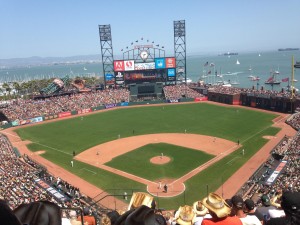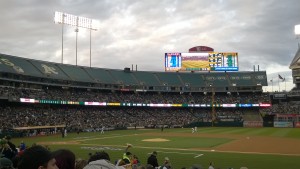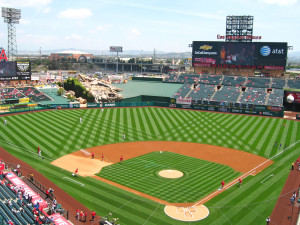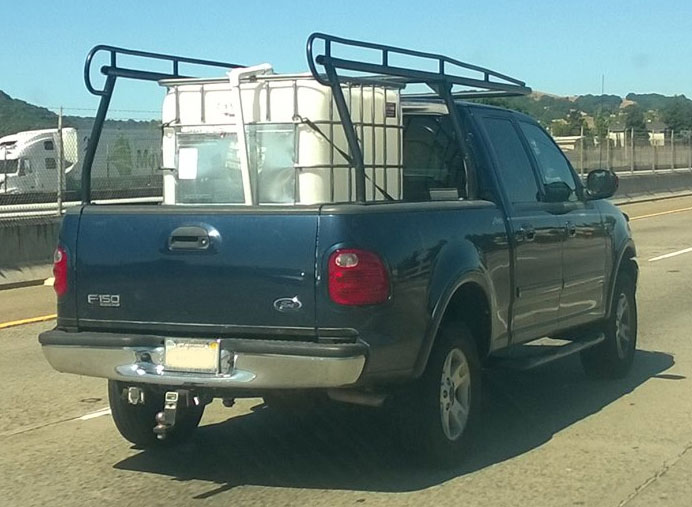The Association of California Water Agencies and Sergio Romo of the World Champion San Francisco Giants have a message for you: “This summer, brown is the new green. Pretty much just let your lawn go brown, keep your watering to a minimum. That’s what’s up.”
The real message: You need to let your grass die so “we” can use that water to keep our playing field green.
Sounds kind of hypocritical to me.

Photo Credit: Taryn Witt
AT&T Park – San Francisco Giants
Last weekend at the Battle of the Bay, between the Green and Gold (California drought colors) Oakland Athletics and the #WeAreGiant San Francisco Giants, the Giants “swept” the A’s – a very drought friendly way to clean up a mess. 😉
The game was played at AT&T Park, a stunning field planted with lush, green, Tifway 419 Bermuda Grass. This kind of turf is perfect for “brown” water sources like effluent from municipal treatment plants. Basically – it’s grass built for Recycled Water.
The recycled water distribution pipeline in San Francisco is vast, San Francisco Power Water Sewer – a service from the San Francisco Public Utilities Commission – has referenced AT&T Park in promotional material as a Recycled Water user in the city, except there is a catch. The playing field is plumbed for recycled water, but it’s not flowing.
Unfortunately, the SF Giants are using Hetch Hetchy potable water on their turf, so they are not putting their money where their mouth is by letting their field go brown. Ironically – of all five Major League Baseball teams in California, AT&T Park is the closest to going online with recycled water, but they are just not reaping its rewards.
This brings up a very interesting thought – how many other MLB stadiums in the state are using recycled water in their ballparks?
Oakland Coliseum – O.co – Oakland Athletics

Taken opening night 2015
The A’s play across the bay in Oakland. But unlike San Francisco, Oakland’s water company – East Bay Municipal Utility District doesn’t have recycled water available at the Coliseum.
Abby Figueroa – Senior Public Information Representative of EBMUD said “The Oakland Coliseum with its expanse of turf would be a great candidate to use recycled water for irrigation. The challenge is location. In Oakland, our plant is located at the foot of the Bay Bridge. It’s a great location adjacent to the shoreline that maximizes gravity to move sewage and wastewater into the plant; the tough part is getting recycled water back out.” Bummer. The A’s keep all that grass green with the same water we get out of the tap.
The groundskeepers at the stadium did do something smart though – the field is planted with “Tifway II Bermuda Grass” which is a drought tolerant, low water using turf grass.
Dodger Stadium – Los Angeles Dodgers

Stolen from Wikipedia.org
The Dodgers play near downtown Los Angeles, their stadium would have been steps from a recycled water pipeline, but nearby residents complained. The Dodgers have expressed interest in using it for their irrigation inside and outside of the park and for use when cleaning the stadium grounds. Recycled water is available all over the Los Angeles basin and is supplied by Los Angeles Department of Water & Power. Just like their nemesis in San Francisco, both teams water their field with potable drinking water.
Here’s an interesting tidbit however, their playing field is planted with “Santa Ana Bermuda Grass” which has a “high degree of tolerance to smog which frequently discolor Tifway and Tifgreen varieties“. Seems ever so fitting that Dodger Stadium needs to use a grass that is tolerant to air pollution. 🙂
Angel Stadium of Anaheim – Los Angeles Angels

Angel Stadium
The Angels play in Anaheim, home to Disneyland & California Adventure Park. Anaheim plays an interesting part in all of this. Starting in 1977, with Water Factory 21 – Orange County Water District (of which Anaheim is apart of) has been using Indirect Potable Reuse to supplement the water supply. Water Factory 21 closed and the Ground Water Replenishment System opened in 2008. The GWRS creates a recycled water so clean its drinkable from the tap, except its injected into the ground and taken out as well water. So while the field is irrigated with “potable” water, it comes from a recycled water resource.
Angel Stadium uses the same grass as at AT&T Park – “Tifway 419 Bermuda Grass” which can survive droughts with minimal water availability. It only needs 1-2″ of water a week but can survive on half that if necessary.
PetCo Park – San Diego Padres

PetCo Park
The San Diego Padres and their downtown stadium sits between some of California’s hottest tech start-ups. But that awesome location comes with a price. Potable water is the only service available as there isn’t a recycled water distribution pipeline in that area of town. Bummer. That will make this next bit even harder to swallow.
For the average San Diegoian, they’ve seen the News10.com reports on how much water Padres Stadium uses. From March 3 to April 1, the stadium used 704,616 gallons (about 24,000 gallons per day). But the Padres pride themselves on their 24% reduction; usage is down 288,000 gallons. That’s neat and all, but how much of that is Recycled Water? None.
On the flip side however, Padres Stadium uses the best grass in the business. Developed at Mississippi State University, “Bulls Eye Bermuda Grass” – also known as MS-Choice, is exactly what players want when it comes to traction on the turf.
So what is a near-term solution? Take a bigger stand than just a short promo video – We know you won’t let the field die as it becomes a player safety issue to catch a fly ball on hard dirt. Times are changing, as this drought wears on, ballparks that have recycled water available should make use of it. For stadiums not already connected – they should invest in recycled water pipelines so that they too can play an active role in water conservation. They can learn from the guy in the following news story, who hauls recycled water 3 times a week to keep his little league field alive.
Sergio Romo has a great point – do conserve water and let your grass go brown. But if that’s not your thing, there are other options available – go get some free recycled water and bring it home to water your lawn, or remove it all together and put in landscaping that fits our climate. Who knows, maybe the water company will pay you to do so.
Play ball!



Leave a Reply